How To Draw A Spotted Seatrout
Spotted Seatrout
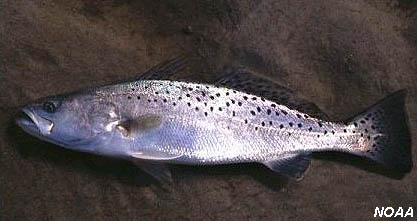
Cynoscion nebulosus
Despite their name, these are not trout, just are in the drum fish family, named from the husky, drumming noise they tin brand. The spotted seatrout have elongated, argent bodies with irregular black spots on the upper half, and can abound to 39 inches long. They alive in seagrass and shallow sandy sea bottoms, venturing into brackish estuaries and up freshwater rivers during cold seasons. They eat crustaceans and small bony fish, lunging at their prey and taking them with long canine teeth and swallowing them whole.
Gild: Perciformes
Family: Sciaenidae
Genus: Cynoscion
Species: nebulosus
Common Names
English language common names include spotted seatrout, seatrout, speckled seatrout, spotted squeteague, spotted trout, and spotted weakfish. Other common names include acoupa pintade (French), corvina (Spanish), corvinata pintada (Spanish), corvinata-pintada (Portuguese), curvina (Castilian), gefleckter umberfisch (High german), kulbiniec plamiasty (Poland), plettet skørfisk (Danish), plettet trommefisk (Danish), pyatnistyi gorbyl' (Russian), and trucha de mar (Castilian).
Importance to Humans
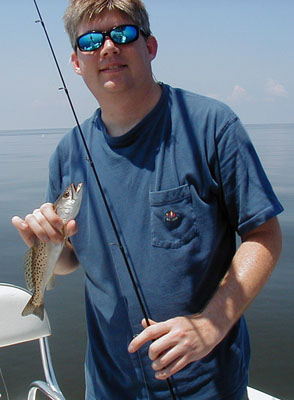
The spotted seatrout is considered important in recreational and commercial fisheries in the Gulf of Mexico. Due to their habitat preference for marshes and estuaries, well-nigh of these fish are taken in state waters. Limited commercial harvest occurs in the waters of Louisiana, Mississippi, and Florida while this fish has been categorized every bit a gamefish in Texas and Alabama.
The mankind of the spotted seatrout has excellent flavor and texture for human consumption. Information technology is often utilized fresh for steaming, broiling, and baking. Upon landing of this fish, it should be placed on ice as rapidly as possible since the mankind loses quality rapidly if not kept chilled. Landed seatrout often have "spaghetti" worms embedded in the flesh (encounter parasite department for more information). These worms cannot survive in humans due to its host specificity, so while in that location is no harm in eating worm-infested seatrout flesh, they can be hands removed during filleting to brand information technology more appealing.
Conservation
The spotted seatrout is not listed every bit endangered or vulnerable with the World Conservation Union (IUCN). The IUCN is a global union of states, governmental agencies, and non-governmental organizations in a partnership that assesses the conservation status of species.
Geographical Distribution
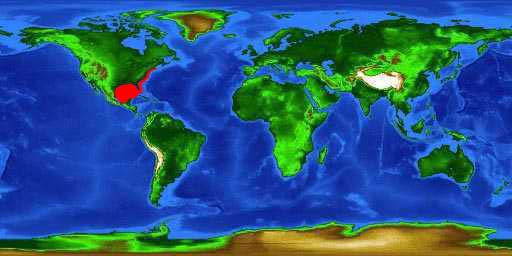
With a range limited to the western Atlantic Ocean, the spotted seatrout is establish from Cape Cod, Massachusetts to southern Florida and throughout the entire Gulf of Mexico.
Habitat
The spotted seatrout is a demersal fish that is constitute in stagnant to marine water. It has been observed in shallow coastal and estuarine waters over sandy bottoms and seagrass to depths of 33 feet (10 m). This euryhaline fish also resides in salt marshes and tidal pools of salinities up to 75‰ (parts per thousand).
During the warm summer months, spotted seatrout associate with seagrass beds, moving to deeper pockets of water in estuaries during the libation months. They rarely migrate far from estuaries where they are spawned.
Biology
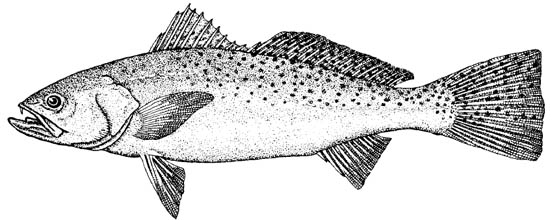
Distinctive Features
The spotted seatrout has an elongate, somewhat compressed body with a slightly elevated dorsum. The head is long with a pointed snout and large oblique oral cavity. The dorsal fin is continuous or slightly carve up. The fins are scaleless with the exception of ane-10 rows of small scales at dorsal and anal fin bases. The lateral line extends onto the tail which is a characteristic of all Sciaenids.
This fish may be confused with others of its genus, especially the weakfish, C. regalis. Still, the spotted seatrout has a distinctive blueprint of black spots scattered along the upper torso and extending into the caudal and dorsal fins. This coloration distinguishes the spotted seatrout from C. regalis and other members of Cynoscion.
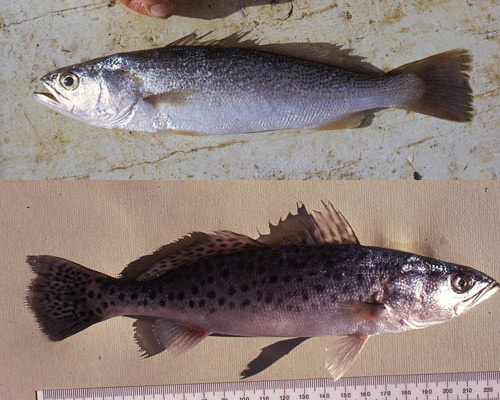
Coloration
The body of the spotted seatrout is silvery with irregular black spots on the upper one-half, from the dorsal to the caudal fin. The dorsal side is nighttime gray with bluish reflections while the ventral side is silvery to white. The dorsal fin is dusky while other fins pale are to xanthous in color. There is a black margin on the posterior edge of the caudal fin.
Dentition
The upper jaw of the spotted seatrout contains a pair of large canine-like teeth with the lower jaw consisting of an enlarged inner row of closely fix teeth. There are no teeth on the vomer, palatines, or natural language.
Size, Historic period, and Growth
The spotted seatrout grows to a maximum length of 39 inches (100 cm) TL (total length) and a maximum weight of 17.v pounds (7.9 kg). Males reach sexual maturity at approximately 2 years of age – 7.9-9.four inches (20-24 cm) standard length (SL), while females mature at 3 years of age – 8.3-9.8 inches (21-25 cm) SL. The expected life bridge of this species is 8-10 years.
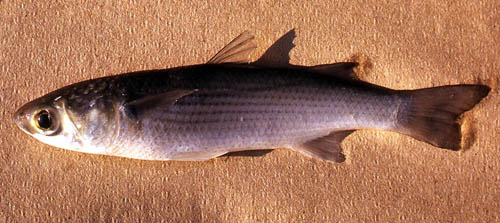
Nutrient Habits
Newly hatched spotted seatrout are planktivores, feeding primarily on copepods. Every bit spotted seatrout abound, there is a dietary shift to larger items including mysids and shrimp. The nutrition of mature spotted seatrout consists of fishes and crustaceans. Casualty species include anchovies, pinfish (Lagodon rhomboides), silversides (Menidia peninsulae), mullet (Mugil cephalus), croaker (Micropogonias undulatus), menhaden (Brevoortia tyrannus), silver trout, snapper, gobies, sheepshead (Archosargus probatocephalus), grunts, toadfish, mojarras, and the occasional seatrout. Developed spotted seatrout swim in small schools with incoming tides and movement into shallow areas to feed. Seatrout are ambush predators, making brusque lunges to take hold of prey with their front canine teeth prior to swallowing it whole.
Reproduction
Spawning activity, controlled primarily by temperature and salinity, peaks in the spring and belatedly summer within the Everglades region in Florida. Forth the gulf coast of Florida, spawning occurs from late March to September with a peak during June through Baronial. Unimodal or bimodal spawning activeness peaks vary temporally and geographically.
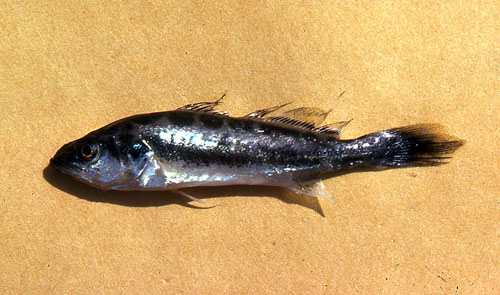
Spawning occurs during the night hours and is signified past the croaking sounds made by males occurring one to ii hours prior to sunset. Shallow bays and lagoons also equally deeper channels and depressions close in proximity to grass flats are utilized as spawning locations by the spotted seatrout. Spawning behavior includes a lot of jumping as well as side to side body contact among individuals.
Fecundity increases with size, with each female person producing xv,000 to 1,100,000 eggs per spawning issue. Spotted seatrout eggs are spherical, measuring approximately 0.70-0.98 mm in diameter, with one to four oil droplets. Eggs are either demersal or pelagic, depending upon salinity. At higher salinities, the eggs are more than buoyant, but sink as salinity decreases beneath 25 parts per thousand (ppt). Optimum salinity for survival of eggs and larvae is approximately 28 ppt.
Larvae hatch nigh 18 hours afterwards fertilization and associate with bottom vegetation or shell rubble. These newly hatched larvae measure one.3-1.6 mm in length when hatched in laboratory settings. At vi-8 weeks of age (25-50 mm in length), the young spotted seatrout oftentimes course schools of up to 50 individuals. Juveniles move to seagrass beds, sandy bottoms, muddied bottoms, oil platforms, and trounce reefs where they continue to live as adults.
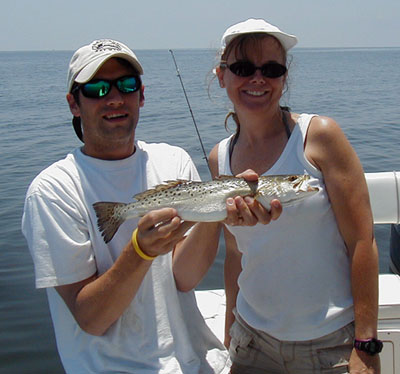
Predators
Predators of the spotted seatrout include alligator gar (Lepisosteus spatula), striped bass (Morone saxatilis), Atlantic croaker (Micropogonias undulatus), tarpon (Megalops atlanticus), and barracuda (Sphyraena barracuda). Other predators include cormorants, brown pelicans, porpoises, and sharks.Parasites
Parasites associated with the spotted seatrout include various isopods, copepods, protozoans, flatworms, and tapeworms. The common worms constitute in the muscle tissue of seatrout, known equally "spaghetti worms", are the pleurocercoid stage of a tapeworm. Anglers sometimes avoid eating the mankind of infested spotted seatrout, notwithstanding there take been no reports of any ill effects suffered from eating infested seatrout.
Taxonomy
This fish was originally named Otolithus nebulosos (Cuvier 1830). The currently valid name is Cynoscion nebulosus (Cuvier 1830). Merely ane synonym for this species appears in by scientific literature, Otolithus carolinensis Valenciennes 1833.
Prepared past: Cathleen Bester
Source: https://www.floridamuseum.ufl.edu/discover-fish/species-profiles/cynoscion-nebulosus/
Posted by: hiserotile1968.blogspot.com


0 Response to "How To Draw A Spotted Seatrout"
Post a Comment